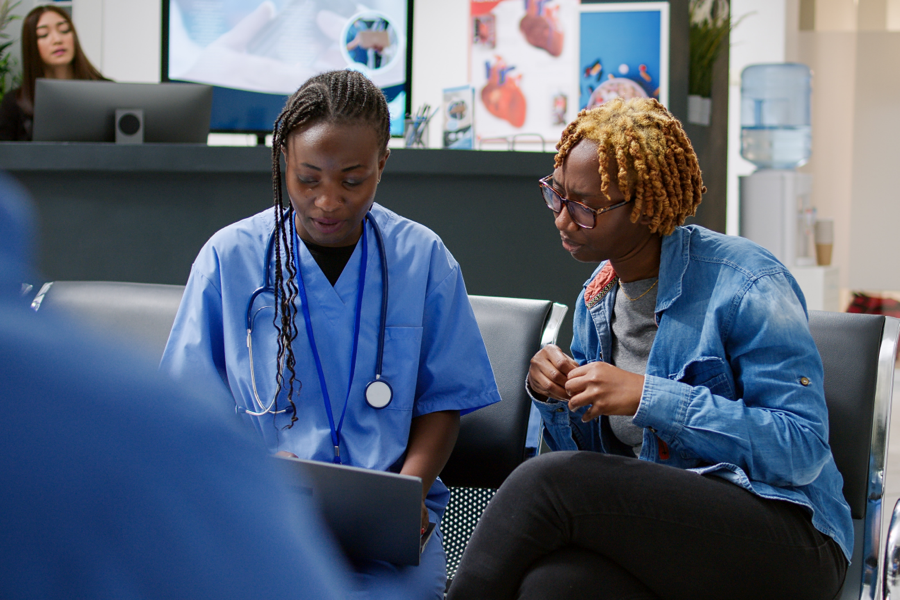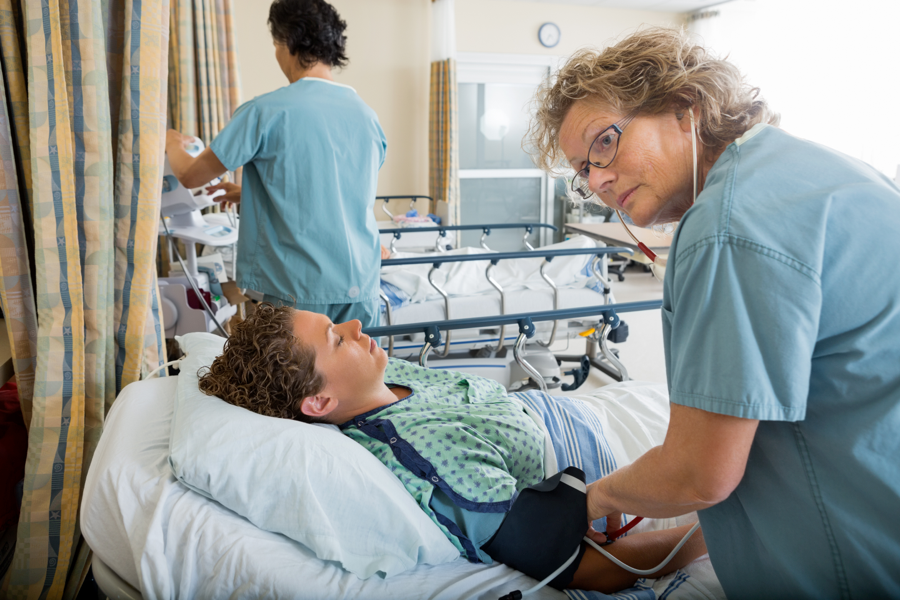
Licensed Practical Nurse
-
 EveryNurse Staff
EveryNurse Staff
- Last Updated: September 30, 2023

One of the fastest and most cost-effective ways to enter the nursing field is to become a Licensed Practical Nurse (LPN). As an LPN, you will be an important member of a healthcare team and work closely with registered nurses and doctors to provide patients with quality healthcare. Becoming a licensed practical nurse is an excellent way to begin a nursing career and gain experience in the field while earning a steady income. You can complete the necessary credentials in as little as one year and about half the cost of becoming a registered nurse.
What Is an LPN?
A licensed practical nurse performs a wide variety of tasks that fall under the category of non-clinical medical care. Common LPN duties include basic medical and nursing care, such as ensuring the comfort of patients, inserting catheters, checking blood pressure, administering medication, monitoring vital signs, and reporting the status of patients to registered nurses and doctors.
In some cases, LPNs also perform basic medical tasks such as blood draws and injections. They can also help in various healthcare settings to support the work of nurse practitioners and physicians by conducting patient assessments such as physical exams and assisting in wound care.
What Does an LPN Do?
Licensed Practical Nurses, referred to as Licensed Vocational Nurses (LVNs) in California and Texas, are essential healthcare professionals. They perform administrative tasks and provide direct patient care in diverse health care settings such as hospitals, nursing homes, physicians’ offices, outpatient care centers, and healthcare facilities.
Practical and licensed vocational nurses perform the same job functions regardless of the differences in their titles. Their duties include patient monitoring, feeding, bathing, taking vital signs, and other basic medical tasks that help keep a patient comfortable and safe. LPNs often assist registered nurses who are performing more complex, specialized functions such as physical therapy, IV therapy, or administering medication.
LPN Job Description
- Assisting RNs in educating patients and family members in caring for specific patient health conditions or injuries
- Collecting blood, urine, and other samples
- Performing routine laboratory tests and reviewing medical records
- Taking a patient’s temperature, blood pressure, and other vital signs
- Completing basic patient care tasks, such as changing a bandage or inserting a catheter
- Monitor patients health for changes in mood and behavior
- Recording services performed for patients in their medical charts
- Preparing patients for their care and describing procedures ordered by their physicians
- Administer medication and IV therapy to patients as prescribed by their physicians
- Providing patients with immunizations and other basic medical care
- Obtaining medical histories from patients when they arrive
What Is the Difference Between an LPN and an RN?
If you are unfamiliar with the key differences between an LPN and an RN, it can be difficult to distinguish between the two. Licensed practical nurses and registered nurses frequently work together and their daily duties often overlap, so it is easy to mistake one for the other.
Fundamentally, both LPNs and RNs perform work that meets the same basic nursing objectives – they care for people with injuries or illnesses and are invested in helping their patients recover as quickly and comfortably as possible. However, everything from their scope of practice and job duties, to their education, compensation, and where they work is very different. A summary of the differences between the professions is provided below.
Scope of Practice
Practical and licensed vocational nurses provide basic nursing care while working under the supervision of either a doctor or a registered nurse. RNs typically have more autonomy and can perform tasks that involve more critical thinking and discretion.
Registered nurses are also better trained in managing more complex cases, including wound care, palliative care, trauma, and cardiac emergencies. Additionally, LPNs are not qualified to start IV fluids or administer any intravenous agent via a central line, both of which are likely to be RN responsibilities.
Education
There are significant differences in how LPNs and RNs are trained. To become an LPN, candidates must earn a diploma or certificate from a state-approved practical nursing program. Practical nursing certification programs take as few as 12 months to complete. LPN programs cover everything from basic nursing skills to sanitation, safety, infection control, and basic health science concepts.
In contrast, becoming an RN requires a college degree – often an Associate’s Degree in Nursing (ADN) or a Bachelor of Science in Nursing (BSN). An associate degree is a two-year degree program with a blended curriculum that covers both liberal arts and nursing topics. BSN programs are more comprehensive – they last for four years and prepare aspiring nurses for advanced nursing roles.
Work Settings
According to the Bureau of Labor Statistics, the most common places of employment for LPNs are nursing and long-term residential care facilities. Approximately 38% of all licensed practical nurses held jobs in this type of work setting.
Hospitals remain the largest employers of registered nurses, with over 60% of the RN workforce employed in this setting. By comparison, only 14% of LPNs work in hospital settings.
Compensation
Registered nurses enter the workforce with greater academic and clinical experience, which justifies a greater scope of practice and higher wages. As a result, the annual wage for an RN is significantly higher than the annual wage for an LPN. Labor statistics show that registered nurses based in the United States typically earn around $89,010 per year, whereas LPNs earn approximately $55,860 per year, on average.
Summary of Steps
How to Become an LPN
01
Complete the Prerequisites
Kickstart your LPN career by meeting the prerequisites necessary for admission to an LPN training program, which often includes specific high school coursework.
02
Pass the TEAS Exam
Prepare and excel in the Test of Essential Academic Skills (TEAS) to qualify for entry into accredited LPN training programs.
03
Complete an Accredited LPN Training Program
Begin your LPN education by enrolling in a recognized practical nursing program to acquire the essential knowledge and skills needed for this profession.
04
Pass the NCLEX-PN Examination
Prepare thoroughly and pass the NCLEX-PN examination to obtain your LPN license and launch your nursing career.
Steps in Detail
1. Complete the Prerequisites
LPN training programs require a high school diploma or GED (a high school equivalency diploma) for admission. Other requirements may include a minimum high school GPA, previous healthcare training, a first aid course, and a CPR certificate. Some schools may also require a letter of recommendation from a current LPN, doctor, or another healthcare professional. In rare situations, LPN certification programs may include college-level classes as a prerequisite.
Basic science courses such as biology, chemistry, anatomy, and math are also recommended before applying to an LPN program. Entering a practical nursing program with a strong foundation in math and science will help you succeed in the program and prepare you to handle basic lab procedures, including lab safety, data collection and analysis, and patient care.
2. Pass the TEAS Exam
3. Complete an Accredited LPN Program
The education requirements for becoming a licensed practical nurse are satisfied by completing an LPN training program accredited by the State Board of Nursing, which is typically offered by vocational schools, community colleges, and private colleges. Programs may take anywhere from one to two years to complete but tend to be shorter in duration, so it is realistic to plan for 12 months of full-time study to graduate.
LPN training programs include both supervised clinical practice and classroom study. Subjects include patient care, anatomy and physiology, pathophysiology, pharmacology, and other nursing topics. In addition, the program must cover education for certification as well as an orientation to current legislative and regulatory affairs. The clinical practice requirement may consist of several hundred hours of work at a healthcare facility under the supervision of a registered nurse.
4. Pass the NCLEX-PN Exam
Once you have earned your LPN credential by completing an LPN program, you are eligible to sit for the NCLEX-PN exam. The National Council Licensure Examination seeks to determine if an applicant is prepared to safely practice as a Licensed Practical Nurse.
National Council Exam subjects include topics such as coordinated patient care, safety and infection control, basic care and comfort, pharmacological and parenteral therapies, and health promotion. Test questions are primarily multiple-choice and are broken down into four major client needs categories
- Safe and Effective Care Environment
- Health Promotion and Maintenance
- Psychosocial Integrity
- Physiological Integrity
LPN Salary
According to the Bureau of Labor Statistics, practical nurses in the U.S. earn a median annual salary of $55,860. While this may seem like a low number when compared to other professionals in the healthcare industry, the average salary for an LPN is still significant for a job without an advanced degree or extensive clinical experience requirements – unlike many other licensed nurses. Additionally, LPNs can increase their salary potential with experience. Top-earning LPNs earned over $72,650 per year according to the BLS.
Highest Paying States for LPNs
| State | Hourly Mean Wage | Annual Mean Wage | Annual 90th Percentile Wage |
|---|---|---|---|
| California | $32.32 | $65,140 | $79,380 |
| Alaska | $30.60 | $63,650 | $77,810 |
| Washington | $30.41 | $63,250 | $77,290 |
| Massachusetts | $29.72 | $61,820 | $76,650 |
| Nevada | $29.08 | $60,490 | $76,980 |
| Oregon | $28.89 | $60,090 | $73,680 |
| Rhode Island | $28.75 | $59,800 | $76,550 |
| Connecticut | $28.58 | $59,400 | $65,460 |
| New Hampshire | $28.43 | $59,140 | $74,250 |
| New Jersey | $28.17 | $58,590 | $70,680 |
The Benefits of Becoming an LPN
Enter the Workforce Quickly
Most LPNs agree that the course length of an LPN training program is an attractive benefit of becoming an LPN. A year of school at an accredited program is the average length of time it takes to graduate with an LPN certification. From there, students can usually begin working within 6-12 weeks of graduation.
By comparison, a bachelor’s degree may take up to four years to complete. This means that a practical nurse has the opportunity to build experience in the workforce for an extra three years. This is especially attractive to students who are concerned about finances and the ability to cover the costs of their education while they develop skills and knowledge while working.
Strong Employment Growth
Meaningful Work
LPN Careers Can Be a Springboard to RN Careers
Becoming a licensed practical nurse first and then going on to earn a registered nurse degree is a viable option for those who are concerned about finances, working hours, or the length of time it takes to complete an advanced degree.
Becoming an LPN first allows students the opportunity to experience the field of nursing and let their skills evolve before they devote their full energy to earning an associate degree or bachelor’s degree. This can be very attractive for those who are interested in becoming nurses but need to balance their time between school and work.
Professional Associations for Practical Nurses
Licensed Practical Nurse FAQ
How long would it take to become a Licensed Practical Nurse (LPN)?
How much do licensed practical nurses make per hour?
Is an LPN higher than a CNA?
LPNs and CNAs frequently work together and their daily duties often overlap, but there are several key differences between the two. The most significant differences between a licensed practical nurse and a certified nursing assistant are their level of education, the scope of practice, and pay.
LPNs provide a higher level of care than CNAs in most healthcare settings, have more legal rights as healthcare practitioners, have more education and clinical training, and are paid more.
Do I need a new LPN license to work in another state?
States that have joined the Nurse Licensure Compact (NLC) share the same uniform licensure requirements which allows nurses to move between states or work in multiple states without having to obtain an additional license. License requirements depend on the state you are moving to and the state you are moving from, so it is important to check with the State Boards of Nursing in each location before you make plans to move.



